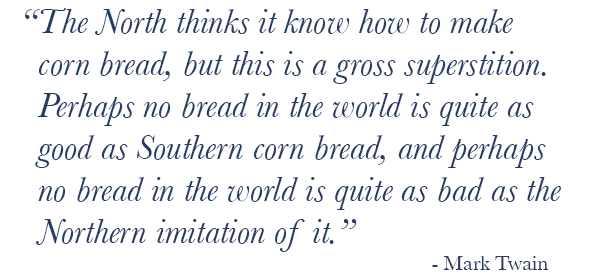
In the South, there are few items that can hold a candle to a belle’s iron skillet. When making out her will, a grandmother may pass down her iron skillet with as much intention as the family china. Why? An iron skillet isn’t just a cooking vessel–it’s an investment of time, a reminder of the care put into it, and a history of everything that the vessel has held before.
A good iron skillet is well-seasoned. That is, over time a surface of lard has built up making the pan non-stick as well as adding a very distinct flavor. Yes, I know your skillet says it’s pre-seasoned but, trust me honey, it’s not. Here’s how to do it right!
To season your iron skillet…
- Preheat your oven to 300°F.
- Thinly coat the inside of your pan with Crisco or canola oil. These are my favorites because they don’t add any particular flavor, and they won’t go rancid on the pan.
- Leave your skillet in the 300° oven for 3 hours, then let cool completely.
- If this is your first seasoning, repeat this process 3 times.
- After the initial seasoning, do this about once every month or two.
- It’ll really start to feel like yours after the first few batches of bacon. I always make these first after seasoning because it adds another layer of flavor.

Cleaning your iron skillet…
Here’s the key: Don’t let it sit. I am one of the worst when it comes to fixing a big meal, and then going straight to bed without cleaning up. This is no way to treat your iron skillet. First of all, the longer you let things sit, the harder they’ll be to clean off. Second, the fat on the bottom of your skillet can begin to pick up flavors you don’t want as it sits.
The other key: Never. EVER. use soap. NEVER! As I said before, the iron skillet is all about the surface. That’s what gives your food flavor and, in turn, that’s what makes your skillet so valuable. So don’t wash it off! Instead…
After you cook, assess your pan.
Is there anything stuck to the bottom?
- Fill your skillet halfway with water, and bring it to a boil for a few minutes.
- Then, empty the water and use a rubber scraper to remove anything that is stuck to the surface.
Everything out, and it just needs to be cleaned?
- When your pan is cool to the touch, throw in a handful of kosher salt.
- Gently rub it in with a rag. (You can use paper towels, but I prefer a rag because paper towels crumble with the salt scrubbing.)
- You’ll see the remnants of dinner being soaked up by the salt.
- Rinse out the salt with water. Dry your skillet. And coat with a thin layer of canola oil or Crisco.
- Store in a dry place. I actually keep mine in the oven.
And now, Iron Skillet Rehab
When a friend brought me a rusty iron skillet a couple of weeks ago, I decided that I’d give it a little rehab and then do a blog post. Little did I know, the rusty surface was thick and flaky so ‘a little rehab’ turned into a Sunday afternoon.
In retrospect, I do not endorse trying to save an iron skillet from the grave. When iron turns to rust, it makes terrible pock marks that can totally ruin the even cooking surface you get with a good skillet. However, if there’s a smaller amount of rust you should be able to use one of the items below, in order of lightest to most abrasive…*
- kosher salt
- steel wool
- a paste of baking soda and water (I rotated this with boiling water and the rust just lifted out.)
- fine grain sand paper
*Note: Using any of these will ruin any seasoning already existing on your skillet.
I think it must be in a belle’s blood to not let an iron skillet die. In the words of a co-worker, “Can’t you buy a new skillet for like $11?” Yes. Yes you can, but that’s not the point. Southern allegiance to your skillet is very real so when you get a skillet of your own take care of it. Cherish it. If you’re good to the skillet, the skillet will be good to you.
Now… what to make in the skillet?
My friend Rebecca Gordon is the most fabulous of cooks! You may remember that I met her in September when we visited with Southern Living in Charleston. We’ll chat a little more with Rebecca later today but, for now, hop on over to Rebecca’s blog Buttermilk Lipstick to get her recipe for the perfect Southern cornbread!



Love the Mark Twain quote! And know I want cornbread…and a whole lotta butter.
We have two iron skillets, one 8″ passed down from my family, and one 12″ that we hunted down at the Longest Yard Sale. My mom taught me decently, though she is a Northerner, and I never use soap, but I am having issues with our skillets. I use them for everything and perhaps that is the problem. Do you cook fish in yours? We sauté fish at least once a week and I have to seriously scrub the skillet to remove the flavor before we make eggs or something else that shouldn’t be fishy. So I feel like we never get that grease layer built-up and are seasoning it from scratch every time we cook. Do I need a dedicated fish pan or are there just a list of things you only cook in your skillet?
You know, I use them for everything too, and I do think that’s probably what is causing you not to have that really seasoned surface. You must scrub with salt (sometimes a couple rounds) to soak up the fish smell–necessary evil. After the initial salt scrubbing, bring 1/2 inch of water to boil for a couple minutes in the bottom of your skillet. This should bring any excess fish oils to the surface that your 2nd round of salt can then soak up.
If you’d like to work on that surface, I’d definitely suggest a “designated egg pan.” Hope that helps!